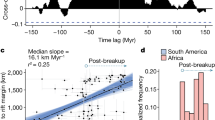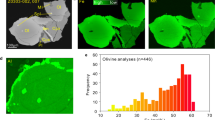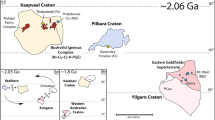Abstract
The geodynamics of Earth and Venus operate in strikingly distinct ways, in spite of their similar size and bulk density, resulting in Venus’s absence of plate tectonics and young surface age (0.2–1 billion years). Venus’s geophysical models have sought to explain these observations by invoking either stagnant lid tectonics and protracted volcanic resurfacing, or by a late episode of catastrophic mantle overturn. These scenarios, however, are sensitive to poorly understood internal initial conditions and rheological properties, and their ability to explain Venus’s young surface age remains unclear. Here we show that long-lived volcanism, driven by early, energetic collisions on Venus, offers an explanation of its young surface age with stagnant lid tectonics. This volcanic activity is fuelled by a superheated core, resulting in vigorous internal melting regardless of initial conditions. Furthermore, we find that energetic impacts stir Venus’s core, suggesting that its low magnetic field is not likely to be caused by a compositionally stratified core, as previously proposed.
This is a preview of subscription content, access via your institution
Access options
Access Nature and 54 other Nature Portfolio journals
Get Nature+, our best-value online-access subscription
$29.99 / 30 days
cancel any time
Subscribe to this journal
Receive 12 digital issues and online access to articles
$119.00 per year
only $9.92 per issue
Buy this article
- Purchase on Springer Link
- Instant access to full article PDF
Prices may be subject to local taxes which are calculated during checkout




Similar content being viewed by others
Data availability
All data are available in the paper, figures or Supplementary Information. Inputs for numerical simulations are described in the text, and available from the corresponding author upon request.
References
Nesvorný, D., Roig, F. V. & Deienno, R. The role of early giant-planet instability in terrestrial planet formation. AJ 161, 50 (2021).
Izidoro, A. et al. Planetesimal rings as the cause of the Solar System’s planetary architecture. Nat. Astron 6, 357–366 (2022).
Emsenhuber, A., Asphaug, E., Cambioni, S., Gabriel, T. S. & Schwartz, S. R. Collision chains among the terrestrial planets. II. An asymmetry between Earth and Venus. Planet. Sci. J. 2, 199 (2021).
Bottke, W. F., Walker, R. J., Day, J. M. D., Nesvorny, D. & Elkins-Tanton, L. Stochastic late accretion to Earth, the Moon, and Mars. Science 330, 1527–1530 (2010).
Marchi, S. et al. Widespread mixing and burial of Earth’s Hadean crust by asteroid impacts. Nature 511, 578–582 (2014).
Marchi, S., Canup, R. M. & Walker, R. J. Heterogeneous delivery of silicate and metal to the Earth by large planetesimals. Nat. Geosci. 11, 77–81 (2018).
Marchi, S., Walker, R. J. & Canup, R. M. A compositionally heterogeneous martian mantle due to late accretion. Sci. Adv. 6, eaay2338 (2020).
Gillmann, C. et al. Dry late accretion inferred from Venus’s coupled atmosphere and internal evolution. Nat. Geosci. 13, 265–269 (2020).
Armann, M. & Tackley, P. J. Simulating the thermochemical magmatic and tectonic evolution of Venus’s mantle and lithosphere: two-dimensional models. J. Geophys. Res. 117, E12003 (2012).
Nakajima, M. et al. Scaling laws for the geometry of an impact-induced magma ocean. Earth Planet. Sci. Lett. 568, 116983 (2021).
Gillmann, C., Golabek, G. J. & Tackley, P. J. Effect of a single large impact on the coupled atmosphere-interior evolution of Venus. Icarus 268, 295–312 (2016).
Arkani-Hames, J. & Olson, P. Giant impacts, core stratification, and failure of the Martian dynamo. J. Geophys. Res. 115, E07012 (2010).
Miyazaki, Y. & Korenaga, J. On the timescale of magma ocean solidification and its chemical consequences: 2. Compositional differentiation under crystal accumulation and matrix compaction. J. Geophys. Res. Solid Earth 124, 3399–3419 (2019).
Miyazaki, Y. & Korenaga, J. A wet heterogeneous mantle creates a habitable world in the Hadean. Nature 603, 86–90 (2022).
O’Rourke, J. G. & Korenaga, J. Thermal evolution of Venus with argon degassing. Icarus 260, 128–140 (2015).
Schubert, G., Turcotte, D. L., & Olson, P. Mantle Convection in Earth and Planets (Cambridge Univ. Press, 2001).
Solomatov, V. S. Scaling of temperature- and stress-dependent viscosity convection. Phys. Fluids 7, 266–274 (1995).
Kasting, J. F. Runaway and moist greenhouse atmospheres and the evolution of Earth and Venus. Icarus 74, 472–494 (1988).
Hamano, K., Abe, Y. & Genda, H. Emergence of two types of terrestrial planet on solidification of magma ocean. Nature 497, 607–610 (2013).
Korenaga, J. Plate tectonics and surface environment: role of the oceanic upper mantle. Earth-Sci. Rev. 205, 103185 (2020).
Grimm, R. E. & Hess, P. C. in Venus II: Geology, Geophysics, Atmosphere, and Solar Wind Environment (eds Bougher, S. W. et al.) 1205–1244 (Univ. Arizona Press, 1997).
Herrick, R. R. & Sharpton, V. L. Implications from stereo-derived topography of Venusian impact craters. J. Geophys. Res. 105, 20245–20262 (2000).
Romeo, I. & Turcotte, D. L. Resurfacing on Venus. Planet. Space Sci. 58, 1374–1380 (2010).
Strom, R., Schaber, G. & Dawson, D. The global resurfacing of Venus. J. Geophys. Res. 99, 10899–10926 (1994).
Le Feuvre, M. & Wieczorek, M. Nonuniform cratering of the terrestrial planets. Icarus 197, 291–306 (2008).
Bottke, W. F. et al. On asteroid impacts, crater scaling laws, and a proposed younger surface age for Venus. In 47th Lunar and Planetary Science Conference (2016).
Turcotte, D. L. An episodic hypothesis for Venusian tectonics. J. Geophys. Res. 98, 17061–17068 (1993).
Moresi, L. & Solomatov, V. Mantle convection with a brittle lithosphere: thoughts on the global tectonic styles of the Earth and Venus. Geophys. J. Int. 133, 669–682 (1998).
Reese, C. C., Solomatov, V. S. & Moresi, L.-N. Non-Newtonian stagnant lid convection and magmatic resurfacing on Venus. Icarus 139, 67–88 (1999).
Parmentier, E. M. & Hess, P. C. Chemical differentiation of a convecting planetary interior: consequences for a one plate planet such as Venus. Geophys. Res. Lett. 19, 2015–2018 (1992).
Smrekar, S. E., Davaille, A. & Sotin, C. Venus interior structure and dynamics. Space Sci. Rev. 214, 88 (2018).
Jacobson, S. A., Rubie, D. C., Hernlund, J., Morbidelli, A. & Nakajima, M. Formation, stratification, and mixing of the cores of Earth and Venus. Earth Planet. Sci. Lett. 474, 375–386 (2017).
Stevenson, D. J., Spohn, T. & Schubert, G. Magnetism and thermal evolution of the terrestrial planets. Icarus 54, 466–489 (1983).
O’Rourke, J. G., Gillmann, C. & Tackley, P. J. Prospects for an ancient dynamo and modern crustal remanent magnetism on Venus. Earth Planet. Sci. Lett. 502, 46–56 (2018).
Springel, V. The cosmological simulation code GADGET-2. Mon. Not. R. Astron. Soc. 364, 1105–1134 (2005).
Melosh, H. J. A hydrocode equation of state for SiO2. Meteorit. Planet. Sci. 42, 2079–2098 (2007).
Thompson, S. L. ANEOS Analytic Equations of State for Shock Physics Codes Input Manual. No. SAND-89-2951 (Sandia National Labs., 1990).
Marcus, R. A., Stewart, S. T., Sasselov, D. & Hernquist, L. Collisional stripping and disruption of super-Earths. Astrophys. J. 700, L118 (2009).
Marcus, R. A. The Role of Giant Impacts in Planet Formation and Internal Structure. PhD thesis, Harvard Univ. (2011).
Ćuk, M. & Stewart, S. T. Making the Moon from a fast-spinning Earth: a giant impact followed by resonant despinning. Science 338, 1047–1052 (2012).
Melosh, H. J. Why the Moon is so like the Earth. Nat. Geosci. 12, 402–403 (2019).
Hosono, N., Karato, S. I., Makino, J. & Saitoh, T. R. Terrestrial magma ocean origin of the Moon. Nat. Geosci. 12, 418–423 (2019).
Canup, R. M. Simulations of a late lunar-forming impact. Icarus 168, 433–456 (2004).
Rufu, R., Aharonson, O. & Perets, H. B. A multiple-impact origin for the Moon. Nat. Geosci. 10, 89–94 (2017).
Alemi, A. & Stevenson, D. Why Venus has no moon. In AAS/Division for Planetary Sciences Meeting Abstracts, Vol. 38 (2006).
Gold, T. & Soter, S. Atmospheric tides and the resonant rotation of Venus. Icarus 11, 356–366 (1969).
Laskar, J. & Robutel, P. The chaotic obliquity of the planets. Nature 361, 608–612 (1993).
Correia, A. & Laskar, J. The four final rotation states of Venus. Nature 411, 767–770 (2001).
Correia, A. C. & Laskar, J. Long-term evolution of the spin of Venus: II. Numerical simulations. Icarus 163, 24–45 (2003).
Zahnle, K. J., Lupu, R., Dobrovolskis, A. & Sleep, N. H. The tethered moon. Earth Planet. Sci. Lett. 427, 74–82 (2015).
Fuller, J., Luan, J. & Quataert, E. Resonance locking as the source of rapid tidal migration in the Jupiter and Saturn moon systems. Mon. Not. R. Astron. Soc. 458, 3867–3879 (2016).
Salmon, J. & Canup, R. M. Lunar accretion from a Roche-interior fluid disk. Astrophys. J. 760, 83 (2012).
Hesselbrock, A. J. & Minton, D. A. Three dynamical evolution regimes for coupled ring-satellite systems and implications for the formation of the Uranian Satellite Miranda. Astron. J. 157, 30 (2019).
Fraeman, A. A. & Korenaga, J. The influence of mantle melting on the evolution of Mars. Icarus 210, 43–57 (2010).
O’Rourke, J. G. & Korenaga, J. Terrestrial planet evolution in the stagnant-lid regime: size effects and the formation of self-destabilizing crust. Icarus 221, 1043–1060 (2012).
Davaille, A. & Jaupart, C. Onset of thermal convection in fluids with temperature-dependent viscosity: application to the oceanic mantle. J. Geophys. Res. 99, 19853–19866 (1994).
Solomatov, V. S. & Moresi, L.-N. Scaling of time-dependent stagnant lid convection: application to small-scale convection on Earth and other terrestrial planets. J. Geophys. Res. 105, 21795–21817 (2000).
Watts, A. B. & Zhong, S. Observations of flexure and the rheology of oceanic lithosphere. Geophys. J. Int. 142, 855–875 (2000).
Forte, A. M., Simmons, N. A. & Grand, S. P. in Treatise on Geophysics 2nd edn, Vol. 1 (ed. Schubert, G.) 853–907 (Elsevier, 2015).
Dobson, D. P., Dohmen, R. & Widenbeck, M. Self-diffusion of oxygen and silicon in MgSiO3 perovskite. Earth Planet. Sci. Lett. 270, 125–129 (2008).
Farnetani, C. G. Excess temperature of mantle plumes: the role of chemical stratification across D". Geophys. Res. Lett. 24, 1583–1586 (1997).
Leng, W. & S. Zhong, S. Controls on plume heat flux and plume excess temperature. J. Geophys. Res. 113, B04408 (2008).
Stolper, E., Walker, D., Hager, B. H. & Hays, J. F. Melt segregation from partially molten source regions: the importance of melt density and source region size. J. Geophys. Res. 86, 6261–6271 (1981).
James, P. B., Zuber, M. T. & Phillips, R. J. Crustal thickness and support of topography on Venus. J. Geophys. Res. Planets 118, 859–875 (2013).
Plesa, A.-C., Tosi, N., Grott, M. & Breuer, D. Thermal evolution and Urey ratio of Mars. J. Geophys. Res. Planets 120, 995–1010 (2015).
Elkins-Tanton, L. T. Linked magma ocean solidification and atmospheric growth for Earth and Mars. Earth Planet. Sci. Lett. 271, 181–191 (2008).
Miyazaki, Y. & Korenaga, J. Inefficient water degassing inhibits ocean formation on rocky planets: an insight from self-consistent mantle degassing models. Astrobiology 22, 713–734 (2022).
Phillips, R. J., Bullock, M. A. & Hauck, S. A. Climate and interior coupled evolution of Venus. Geophys. Res. Lett. 28, 1779–1782 (2001).
Gillman, C. & Tackley, P. J. Atmosphere/mantle coupling and feedbacks on Venus. J. Geophys. Res. Planets 119, 1189–1217 (2014).
Breuer, D. & Moore, W. B. in Treatise on Geophysics 2nd edn, Vol. 10 (ed. Schubert, G.) 255–305 (Elsevier, 2015).
Wolstencroft, M. & Davies, J. H. Influence of the ringwoodite–perovskite transition on mantle convection in spherical geometry as a function of {Clapeyron} slope and {Rayleigh} number. Solid Earth 2, 315–326 (2011).
Hirose, K. Phase transitions in pyrolitic mantle around 670-km depth: implications for upwelling of plumes from the lower mantle. J. Geophys. Res. 107, B2078 (2002).
Fei, Y. et al. Experimentally determined postspinel transformation boundary in Mg2SiO4 using MgO as an internal pressure standard and its geophysical implications. J. Geophys. Res. 109, B02305 (2004).
Ohtani, E. & Litasov, K. D. The effect of water on mantle phase transitions. Rev. Mineral. Geochem. 62, 397–420 (2006).
Ballmer, M. D., Schmerr, N. C., Nakagawa, T. & Ritsema, J. Compositional mantle layering revealed by slab stagnation at ~1000-km depth. Sci. Adv. 1, e1500815 (2015).
Rolf, T., Steinberger, B., Sruthi, U. & Werner, S. C. Inferences on the mantle viscosity structure and the post-overturn evolutionary state of Venus. Icarus 313, 107–123 (2018).
Uppalapati, S., Rolf, T., Crameri, F. & Werner, S. C. Dynamics of lithospheric overturns and implications for Venus’s surface. J. Geophys. Res. Planets 125, e06258 (2020).
Way, M. J. et al. Was Venus the first habitable world of our solar system? Geophys. Res. Lett. 43, 8376–8383 (2020).
Krissansen-Totton, J., Fortney, J. J. & Nimmo, F. Was Venus ever habitable? Constraints from a coupled interior–atmosphere–redox evolution model. Planet. Sci. J. 2, 216 (2021).
Modirrousta-Galian, D. & Korenaga, J. The three regimes of atmospheric evaporation for super-Earths and sub-Neptunes. Astrophys. J. 943, 11 (2023).
Lourenço, D. L., Rozel, A. B., Ballmer, M. D. & Tackley, P. J. Plutonic‐squishy lid: a new global tectonic regime generated by intrusive magmatism on Earth‐like planets. Geochem. Geophys. Geosyst. 21, e2019GC008756 (2020).
Korenaga, J. On the likelihood of plate tectonics on super-Earths: does size matter? Astrophys. J. 725, L43–L46 (2010).
Davaille, A., Smrekar, S. & Tomlinson, S. Experimental and observational evidence for plume-induced subduction on Venus. Nat. Geosci. 10, 349–355 (2017).
Gülcher, A. J. P., Gerya, T. V., Montési, L. G. J. & Munch, J. Corona structures driven by plume–lithosphere interactions and evidence for ongoing plume activity on Venus. Nat. Geosci. 13, 547–554 (2020).
Walker, R. J. Highly siderophile elements in the Earth, Moon and Mars: update and implications for planetary accretion and differentiation. Geochemistry 69, 101–125 (2009).
von Zahn, U., Kumar, S., Niemann, H. & Prinn, R. in Venus (eds Hunten, D. M. et al) 299–430 (Univ. Arizona Press, 1983).
Acknowledgements
S.M. acknowledges internal support from the Southwest Research Institute and D. Nesvorný for providing impact velocity files from numerical integrations. R.R. is supported by NASA through a NASA Hubble Fellowship grant no. HST-HF2-51491 awarded by the Space Telescope Science Institute, which is operated by the Association of Universities for Research in Astronomy, Inc., for NASA, under contract NAS5-26555.
Author information
Authors and Affiliations
Contributions
S.M. conceived the work and analysed the SPH simulations. R.R. ran the SPH simulations. J.K. ran and analysed the geophysical calculations. All authors contributed to the interpretation of the results and writing of the paper.
Corresponding author
Ethics declarations
Competing interests
The authors declare no competing interests.
Peer review
Peer review information
Nature Astronomy thanks the anonymous reviewers for their contribution to the peer review of this work.
Additional information
Publisher’s note Springer Nature remains neutral with regard to jurisdictional claims in published maps and institutional affiliations.
Supplementary information
Supplementary Information
Supplementary Figs. 1–9 and their captions.
Rights and permissions
Springer Nature or its licensor (e.g. a society or other partner) holds exclusive rights to this article under a publishing agreement with the author(s) or other rightsholder(s); author self-archiving of the accepted manuscript version of this article is solely governed by the terms of such publishing agreement and applicable law.
About this article
Cite this article
Marchi, S., Rufu, R. & Korenaga, J. Long-lived volcanic resurfacing of Venus driven by early collisions. Nat Astron 7, 1180–1187 (2023). https://doi.org/10.1038/s41550-023-02037-2
Received:
Accepted:
Published:
Issue Date:
DOI: https://doi.org/10.1038/s41550-023-02037-2
This article is cited by
-
Old impacts ignite young volcanism
Nature Astronomy (2023)



